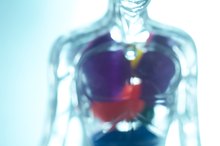What does fact checked mean?
At Healthfully, we strive to deliver objective content that is accurate and up-to-date. Our team periodically reviews articles in order to ensure content quality. The sources cited below consist of evidence from peer-reviewed journals, prominent medical organizations, academic associations, and government data.
- Mayo Clinic. (2018). Stool color: When to worry.
- Parasites - Giardia: Sources of infection & risk factors. (2015).
- Stool changes: What do they mean? When should I see a doctor? (n.d.).
The information contained on this site is for informational purposes only, and should not be used as a substitute for the advice of a professional health care provider. Please check with the appropriate physician regarding health questions and concerns. Although we strive to deliver accurate and up-to-date information, no guarantee to that effect is made.
Yellow Stools & Stomach Pain
Yellow stools and abdominal pain can indicate a variety of medical conditions. Some of these conditions are common and some are not 2. Regardless of the cause, when a patient experiences yellow stools and abdominal pain they should contact a physician for a diagnosis 4. It is important that all causes are properly diagnosed to avoid any potentially serious future health complications.
If you are experiencing serious medical symptoms, seek emergency treatment immediately.
Hepatitis
Patients with hepatitis may experience yellow stools and abdominal pain. Hepatitis is a viral condition characterized by liver inflammation. There are five types of hepatitis: hepatitis A, hepatitis B, hepatitis C, hepatitis D and hepatitis E. All forms of hepatitis have different causes and treatment methods. They also have different symptoms, but since all five forms of hepatitis affect the liver, jaundice can occur. Jaundice is a condition in which the eyes and skin take on a yellow hue.
- Patients with hepatitis may experience yellow stools and abdominal pain.
- They also have different symptoms, but since all five forms of hepatitis affect the liver, jaundice can occur.
Celiac Disease
Gallstones, Lecithin & Rowachol
Learn More
Celiac disease is a genetic gluten intolerance. It often has an underlying autoimmune cause. Patients with this condition often experience yellow stools and abdominal pain as well as diarrhea and abdominal bloating. Treating celiac disease most often involves following a gluten-free diet.
- Celiac disease is a genetic gluten intolerance.
- Patients with this condition often experience yellow stools and abdominal pain as well as diarrhea and abdominal bloating.
Cholangitis
Cholangitis is a condition in which a patient's bile duct is inflamed. In addition to yellow stools and abdominal pain, patients may also experience pain underneath their right shoulder blade, jaundice, gas, nausea and vomiting. According to Medline Plus, this condition is most often caused by a bacterial infection. Antibiotics and surgery are the most common treatment methods.
- Cholangitis is a condition in which a patient's bile duct is inflamed.
- According to Medline Plus, this condition is most often caused by a bacterial infection.
Gallstones
Gallbladder Disease and Fatigue
Learn More
Gallstones are solid chemical deposits in the gallbladder. The symptoms of gall stones include yellow stools, abdominal pain, indigestion, nausea and vomiting. Gallstones can be treated by surgically removing them or by using shock waves to break them up.
Pancreatic Insufficiency
Pancreatic insufficiency is a condition in which the pancreas is not functioning properly. This condition can be caused by a number of medical problems, including chronic pancreatitis, pancreatic cancer, pancreatic resection and cystic fibrosis. In addition to yellow stools and abdominal pain, patients with pancreatic insufficiency may experience weight loss and glucose intolerance. Treating this condition consists of diagnosing and treating the underlying condition. Treatment also involves managing the symptoms when possible. Patients may need to be on a high-protein, low-fat diet to help them maintain and gain weight if necessary as well as take vitamin A, D, E and K supplements.
- Pancreatic insufficiency is a condition in which the pancreas is not functioning properly.
- In addition to yellow stools and abdominal pain, patients with pancreatic insufficiency may experience weight loss and glucose intolerance.
Related Articles
References
- Mayo Clinic. (2018). Stool color: When to worry.
- Palsson OS, et al. (n.d.). Hormones and IBS.
- Parasites - Giardia: Sources of infection & risk factors. (2015).
- Stool changes: What do they mean? When should I see a doctor? (n.d.).
- Centers for Disease Control and Prevention (CDC). Hepatitis A: Questions and Answers for the Public. Updated November 2, 2017.
- Centers for Disease Control and Prevention (CDC). Viral Hepatitis: Statistics and Surveillance. Updated May 11, 2017.
- World Health Organization (WHO). Global Hepatitis Report, 2017. Geneva. 2017.
- World Health Organization (WHO). Hepatitis C. Updated October 2017.
- World Health Organization (WHO). Hepatitis D. Updated July 2017.
Writer Bio
Rose Kitchen is a freelance medical writer pursuing a bachelor's degree in sociology and education. She has a nursing background and is going back to nursing school in September 2011 for her R.N. Kitchen holds a certificate in anatomy and physiology and English and is pursuing certificates in natural and alternative medicine, fitness and nutrition and sports nutrition.









